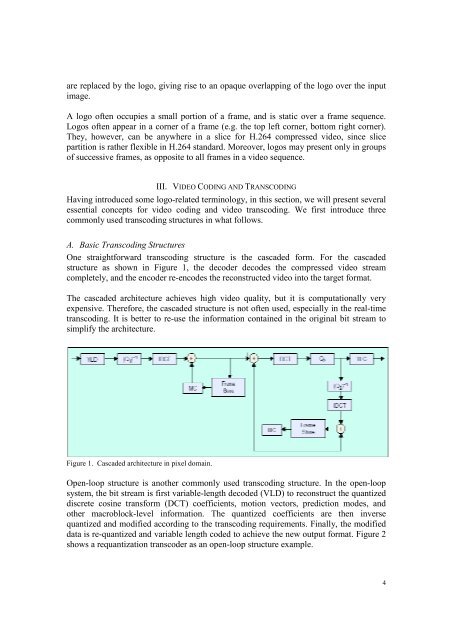EECE 541 Multimedia Systems Project Proposal: Logo ... - Courses
EECE 541 Multimedia Systems Project Proposal: Logo ... - Courses
EECE 541 Multimedia Systems Project Proposal: Logo ... - Courses
Create successful ePaper yourself
Turn your PDF publications into a flip-book with our unique Google optimized e-Paper software.
are replaced by the logo, giving rise to an opaque overlapping of the logo over the input<br />
image.<br />
A logo often occupies a small portion of a frame, and is static over a frame sequence.<br />
<strong>Logo</strong>s often appear in a corner of a frame (e.g. the top left corner, bottom right corner).<br />
They, however, can be anywhere in a slice for H.264 compressed video, since slice<br />
partition is rather flexible in H.264 standard. Moreover, logos may present only in groups<br />
of successive frames, as opposite to all frames in a video sequence.<br />
III. VIDEO CODING AND TRANSCODING<br />
Having introduced some logo-related terminology, in this section, we will present several<br />
essential concepts for video coding and video transcoding. We first introduce three<br />
commonly used transcoding structures in what follows.<br />
A. Basic Transcoding Structures<br />
One straightforward transcoding structure is the cascaded form. For the cascaded<br />
structure as shown in Figure 1, the decoder decodes the compressed video stream<br />
completely, and the encoder re-encodes the reconstructed video into the target format.<br />
The cascaded architecture achieves high video quality, but it is computationally very<br />
expensive. Therefore, the cascaded structure is not often used, especially in the real-time<br />
transcoding. It is better to re-use the information contained in the original bit stream to<br />
simplify the architecture.<br />
Figure 1. Cascaded architecture in pixel domain.<br />
Open-loop structure is another commonly used transcoding structure. In the open-loop<br />
system, the bit stream is first variable-length decoded (VLD) to reconstruct the quantized<br />
discrete cosine transform (DCT) coefficients, motion vectors, prediction modes, and<br />
other macroblock-level information. The quantized coefficients are then inverse<br />
quantized and modified according to the transcoding requirements. Finally, the modified<br />
data is re-quantized and variable length coded to achieve the new output format. Figure 2<br />
shows a requantization transcoder as an open-loop structure example.<br />
4
















